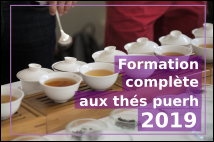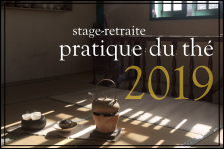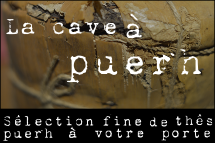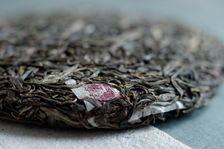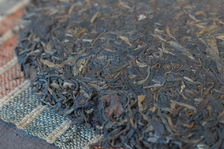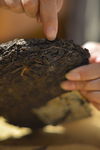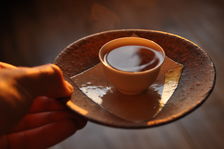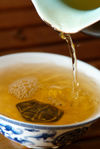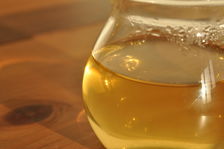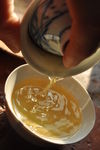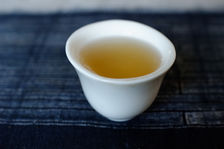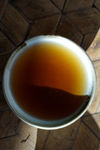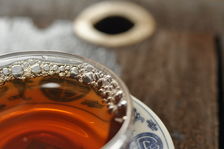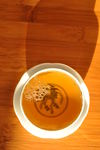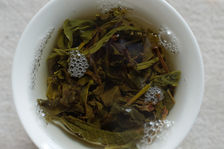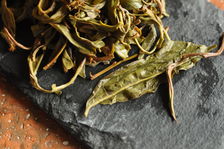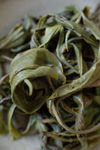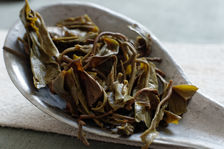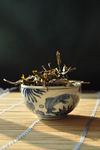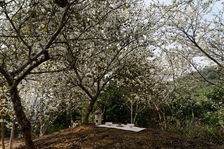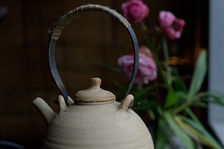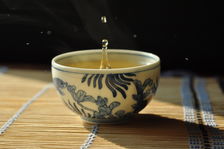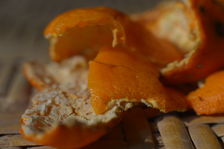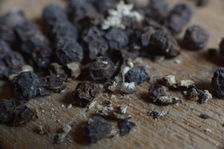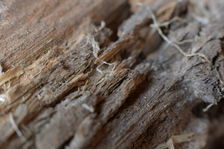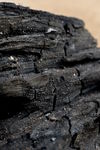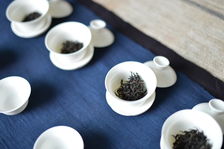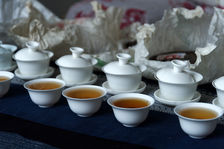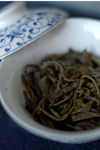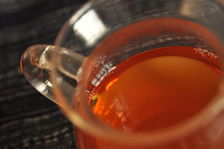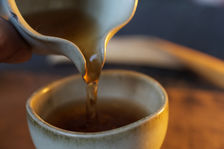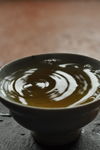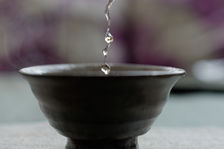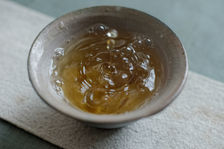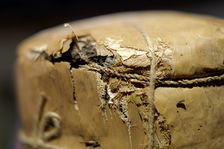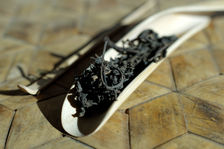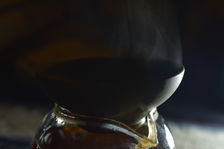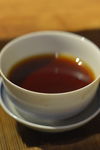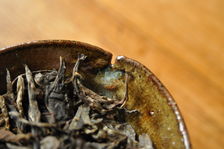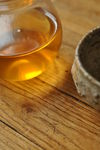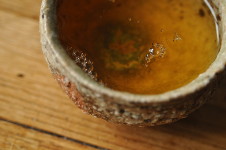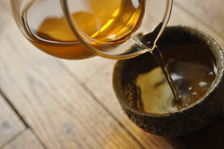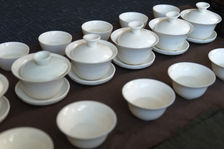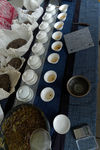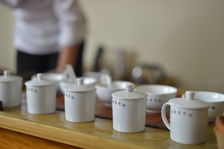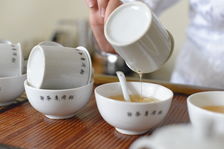 This page is not a real translation but just an automatic translation generated by computer of the original article, written in French language! Its not good... but better than nothing!
This page is not a real translation but just an automatic translation generated by computer of the original article, written in French language! Its not good... but better than nothing!Want to help us do diffuse puerh tea culture in english, by providing a better (or corrected) translation?
Please contact us!

When you drink a cup of tea, we are overwhelmed by a multitude of sensations. Colors, aromas, flavors, textures, coming simultaneously touch our senses and produce emotion.
At the heart of this explosion of sensations, the amateur neophyte is often lost, overwhelmed by a flood of sensory information. There remains a very general impression, a "like" or "I do not like" the beginner's hard to overcome. Sometimes the contrary, a given sensation strikes the attention and then disappears with the impression of not being able to grasp, fix, leaving a feeling of frustration.




- 1.Tea tasting (Tea Room Author)
- 2.Tea tasting in Kunming
- 3.tea tasting (Kucong Shan Zhai)
- 4.tea tasting with Deng Shi Hai
Some will like this report to tea, a blissful and mysterious admiration as one can have in late at night in the vastness of a starry sky. But under the same sky others will want to go further, learn to recognize the stars, their positions, their disposal, to make the sky a little more his, to navigate, to keep track in the mind, or to share with others what he observes.
Learning the tasting that vocation:the unraveling ball of various sensations and varied as tea produced on us and break down in order to judge them, describe the storing and sharing. Although it may seem difficult to him who starts, it is an exercise to everyone, with a minimum of method and attention.
This article will give you some great keys and tips to discover and introduce you to the art and technique of tasting. It compiles a number of bases for the art of tasting and more personal note, the fruit of years of taste puerh (Pu Er tea) teas.
Do not worry if it seems difficult at first, the practice of tasting requires a lot of attention and concentration at first, but with time and practice it becomes a reflex which can not even think.
The places of tasting
Tasting involves all the senses or so, and the taster therefore pays close attention to the distinct expression of each direction. The eye First, observation with the tea leaves and that of liquor. The face Then, with the assessment that the tea fragrance emerges. Finally, the taste , or rather tastes that develop during and after drinking the tea. Some teas are also other types of emotion , that seem to transcend the senses by directly touching the body and mind, and about which the Chinese speak mind or energy tea ( cha qi ).
The eye
The first contact with the tea is generally visual. We begin by observing the tea leaves. Whether loose or compressed cake, this observation already gives extensive information on the nature and quality of the tea.



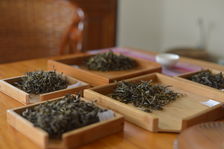
- 1.puerh tea leaves
- 2.Tea leaves puerh
- 3. puerh (Pu Er tea) tea leaves
- 4.Comparison of different leaves puerh (Pu Er tea) tea
It will be noted in particular the quality of the work sheets (drying, rolling), the presence or absence yellow leaves (which should be removed when sorting for a fine production), grade or age (size) of the leaves, the presence of buds and their proportion, etc. Observation of leaves also provides information on the harvest season, and tells us if the leaves have summers assemblies or rather if they come from a single harvest.
When tea is compressed, the observation of the cake also provides information on the production thereof. Is it a powerful hydraulic pressing, or conversely a light pressing to stone? It is the homogeneous pressing (which is important to allow a homogeneous maturation)?
Manual Compression against mechanical compression
Tea cakes can be compressed in various ways producing different outcomes. Initially the patties were compressed in the traditional way with heavy stones. Pressing the stone generally produces low compressed cakes that easily délassent whose maturation can be promoted. Back in fashion in the 90's this type of compression is preferred by some fans for its craftsmanship and traditional look, or to ease that we have to extract the tea leaves.However, some criticize him too little compression to ensure conservation and manipulation over the very long term, and when the press is not perfectly controlled inhomogeneity of the cake, and then prefer a mechanized compression.
Developed after 50 years with the tea sector industrialization this type of compression used a mechanical press. It generally produces more compressed patties, more regular and resistant to time, which will offer a slower maturation but also a more difficult and less clean extraction of the tea leaves.
If it was obvious to the 2000s, technology has evolved a lot since then and now offer various factories mechanized or hybrid cuts so close to the results that the traditional way is obtained that it is difficult or impossible distinguish them.
For that some producers do not hesitate to innovate by changing the commercial presses, involving stone in the mechanical process or for the more daring by performing a double compression, mechanical and manual to get the best of both methods .
For teas few years or older, observation sheets also gives the taster much information when storing and maturing tea. As we age the tea leaves will change color effect and gradually slipping from green to brown. The observation of the color of the leaves and allows the taster to predict the age of the tea, but also the nature of storage (natural storage more or less dry, traditional storage Hong Kongers, etc.) and its quality.
Judging maturation, an equation with one unknown
Puerh tea evolves with time. Year after year, while its aromas that turn the color of its leaves and its liquor darkens to drag the red-brown, allowing the taster to evaluate the age and experience of the tea.But this maturation is highly dependent on conditions in which the puerh (Pu Er tea) tea was stored. A more humid atmosphere, as it is natural or artificially produced, will cause a more rapid maturation if the tea had been stored in a dry environment.
In this sense the age tea , storage conditions and apparent maturation tea , are three notions closely linked and dependent on each other. The taster will therefore need to be information about storage conditions a tea to deduce reliably the age of this one, or on the contrary will need to know about the approximate age of a tea to predict conditions storage of the latter.
Tea storage conditions, however, often have an influence on the flavor character of this one and in most cases a qualified taster may from tea aromatic character to get a first fairly reliable idea of how tea was stored.
The observation of the leaves also identify a number of information or defects related to the storage of tea:change in volume or shape of the cake, the presence of white substances associated with excessive moisture or an incomplete drying, traces insects, etc ...
But the liquor produced by the infusion of the leaves, the dress Looks like wine taster, it also provides valuable information about the quality of tea and storage. To judge the liquor will be used a pitcher or cup is transparent or white.
Transparent pitcher allows smooth and uniform to properly judge the color and brightness of the liquor when it is traversed by the light. A pitcher or a white cup allows observing the disk, ie the surface of the liquor, to judge the liquor by the reflection of light on the bottom of the cup or pitcher. The use of a white utensil is however less easy than that of a transparent utensil and beginners usually prefer the glass. Finally Avoid cups or unglazed earthen pitcher or color, which does not allow an objective judgment of the liquor.
To observe the liquor will take care to place in a calm and bright space. Will be positioned to the cup or pitcher so that light, a ray of sunshine for example, or the light of a lamp through the liquid. Please move your cup to find the ideal position. The taster then note what characterizes the liquor, and particularly four main points:the color , the current his clarity and brightness .
Usually done by analogy to judge the color tea, trying to define as precisely as possible the color of the liquor. Thus, for example, speak of a liqueur flesh peach, apricot, copper for a young raw puerh, or liquor cherry, ruby, or chestnut for fermented or older puerh.
The current is then used to refine the hue using adjectives such as light, dark, deep, intense, brilliant or instead fade, faded, dull .
Hue and intensity sometimes give indication of the quality of the tea. For example, in some regions like Da Shan Xhe a particularly pale colorless liqueur see for a young puerh (Pu Er tea) will often reflect the quality and age of the trees, and old puerh (Pu Er tea) a ruby red color will usually seen as a sign of quality.
The color of the liquor, as leaf color, we also provide information on the age of the tea, method of storage and fermentation level. Naturally a darker liquor brand will be greater fermentation, which may as appropriate to reflect a later age tea, wetter natural storage or assisted further fermentation.
clarity and brightness when wearing them on the ability of the liquor to reflect light. clarity describes how light passes through the liquid. A good liquor will clear, pure, light , where a clumsy transformation leaves or failure to store liquor can produce problems or veiled .
Related to the clarity, brightness is the ability of the liquor to reflect the light, to make it shiny. It will be appreciated primarily liqueurs Bright, vivid, over liqueurs dull, bland or flat .
Also how light enters the liquor, the taster will also observe the disk, ie the surface of the liquor, which also provides information about the quality of the tea. Again we first judge disk capacity to reflect light. By varying the angle of the light disk also reveals some kind of scrolls, very fluid and whose curves are changing the slightest draft.
These are generally reflected in the case of young puerh (Pu Er tea) particular richness of the leaf and the tree it comes from, and in the case of old puerh (Pu Er tea) suggests the quality and depth of fermentation.
Or the eye, which introduced the tasting, usually also comes close. Once the observed leaves, felt, tasted the tea and infusion after infusion shelled its subtle flavors, again comes the time of observation. It is this time more to see the dry leaves, ready to be enjoyed, but the infused leaves that have generated tea we just drink.
Even more than the dry leaves, which can be misleading, the infused leaves speak of the origin of tea, its quality, its production and maturation. Including the size will be observed (grade) of the leaves, but also their integrity, ribbing, thickness and strength, defects such as burns or broken, all of which will confirm or refute visually deductions taste taster.
The nose
The nose of tea, its fragrant and aromatic dimension ( Xiang ) is one of the main criteria of quality tea. This is probably one of the most complex and elusive attributes. But it is also the tea has more fragile, and the slightest defect in the production or storage of tea will lose its olfactory tea wealth.
Nose young and old puerh:two very different worlds
Although from the same tea, puerh (Pu Er tea) puerh and senior youth have very different olfactory universe.The nose of a young puerh, let alone of a href='http://www.puerh.fr/article/comprendre_les_puerh_primeurs.htm' scoop is an essential component of these teas, and must be rich and complex, either by direct olfaction or palate. Depending on the age of the tea develops a bouquet flower (typical of the early years), sometimes Spicy or more fruity (often sign a beginning of maturation).
Aged puerh (Pu Er tea) expressed when to them with secondary aromas, built by the time the maturation of tea. Far from the flowers and fruit of youth, the nose of an old puerh (Pu Er tea) plays in general, and depending on its age, in chills camphor , the Spice racy, aromas dates or nuts and a variety of characters boisésplis briefly cup .
The storage of tea, its nature and quality are also reflected largely in the tea nose. The observation of this one and will predict the moisture level in which tea has matured, but also various defects of storage, including the presence of odors "cellar", or moist, signs of bad wet storage or incomplete re-invigoration.
Smell is one of our most complex sense but it is also the most "wild" and least trained. If the eye or touch judge is a dimension rather easily and accurately, if the ear perceives without much difficulty the pitch of a musical note, olfactory sensations often seem elusive and mysterious to the neophyte, and return without we do not know why this or that perfume or sometimes deeply buried memories.
Child it is common to feel everything that happens to us in a nose or arm, but this usually disappears quickly growing, and in the bustle of our societies generally forget the multitude of smells that surround us. Learn how to taste it first arouse attention and curiosity of the child who discovers for the first time odors and maintain this attention to the olfactory universe.
This is an exercise in every moment during the course tasting, but also beyond, as it is in "fixing" everyday odors that surround the taster expands gradually sensitivity and the directory that it then allow to recognize or categorize a given olfactory sensation.
Tea nose is broken down into two phases, the first nose is the odors , which perceives before drinking tea and based . Then comes the second nose , the flavors , we will perceive ending , once swallowed tea.
First nose smells time
The appreciation of the odors generally precedes the tasting. This is an important step because it not only provides a lot of information on tea that will be enjoyed, but it also prepares the mind to receive the tea, and so determines the result of the tasting.
Dry leaves puerh (Pu Er tea) tea generally have very little odor, especially if they already have a number of years. To collect the raw smell can make those leaves in a teapot or a blank Gaiwan, which has previously heated by completing the time of boiling water. After a few seconds in hot and humid container, the leaves begin to release their fragrance, which can then enjoy putting his nose above the teapot or Gaiwan and inhaling deeply.
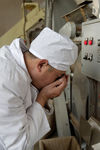
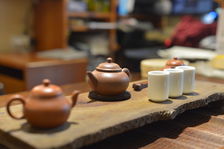
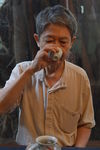
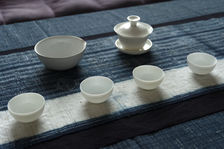
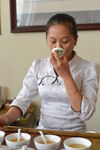
- 1.Judgment of the nose leaves freshly fermented black tea
- 2.Mugs Senir the Wulong
- 3.Chow yu feeling a Wulong
- 4.Different utensils to smell the fragrance of tea
- 5.smells satisfaction with a teacup
But the biggest perfumes will judge after the first infusion of the leaves. It is generally not drink the first infusion of a few seconds, but in the preferred perfumes. For it can not be felt directly leaves, which are usually only slightly expressive but subtle perfume left by the passage of the infusion on a surface such as the lid of a Gaiwan. After a few seconds of infusion, the taster pours the liquor, then lifts the lid of Gaiwan, slightly aerated by turning it small movements before you approach her nose and inhale deeply. It is also possible to use some pitcher or cup after briefly filled and emptied.
Cup to feel and tea puerh (Pu Er tea)
The oolong teas may have more than any other tea, exalted the perfume and the art of enjoying them. It is used for a particular elongated cup specially designed to allow a sharp perception of tea flavors. For this we briefly filled the cup to smell of tea, then it is empty before to appreciate the subtle flavors remained prisoners of the cup ...Whoever tried such a cup with a tea puerh (Pu Er tea) not fail in general to be disappointed with the result. Indeed each type of fragrance is a form and matter, and if the cup of oolong feel works especially well with the flavors of oolong it generally does not allow the perfume puerh (Pu Er tea) be fully expressed.
Puerh tea being traditionally not recognized as a tea nose, there is no in the world of puerh (Pu Er tea) equivalent to cup of oolong feel, and is generally used to assess an odor utensil of the tasting, as the cover of Gaiwan which usually gives excellent results, a pitcher, see one of the cup in which it is used tea.
The shapes and materials of the vessels may change, it is necessary before judging tea making preliminary tests to verify that the utensil in question allows to appreciate the odors of puerh (Pu Er tea) tea.
The first nose is the first contact with the scents of tea. It says something about the quality of tea, its richness, complexity, ability to rependre into nasal cavity and persistent. It also usually provides fairly reliable clues when the age of the tea, and the nature and quality of storage.
The experienced taster will go even further, and only from the first nose can sometimes predict fairly accurately how tea will speak during the upcoming tasting, nose course, but also in the mouth, or throat.
Second nose, aromas of time
The second face is that of flavors . Unlike odors, which are what we perceive "outside" when we breathe, the aromas are what we perceive "inside" after drinking the tea. This is indeed the time to pass through the mouth, then being swallowed, the tea gives off most of its aromatic richness. Now the olfactory cells are not found in the mouth but on the top of the nasal cavity, and can not directly perceive these flavors. That's why when we taste tea it is important to always inspire through the mouth, then gradually exhale through the nose. During this end, breath in charge of tea flavors will excite the olfactory cells making them noticeable aromas. This is what is called retro olfaction.
During this short time expires, and if the tea is good, the taster will be overwhelmed by a multitude of olfactory sensations. Sometimes very ephemeral it may seem difficult at first to distinguish the different flavors, the "fix" before they disappear, change or be replaced with the arrival of other flavors. Again it will be for the taster to unravel this skein sensations to highlight that composes.
Describe and assess nose
Describe the nose, ie put words on its olfactory sensations, is the first step to understand and control these feelings. This is not only useful for contact and exchange with others about some tea, but also to better understand and remember the character of a given tea.
Before the olfactory complexity of a good tea, the taster is faced with a complex landscape, full of details, and he will describe. Instead of getting lost it will start by asking an overall plan, to draw the nose of tea in the outline. It will then gradually go in tea and observe more closely the details that make aromatic personality.
Thus will begin by asking about the various objective aromatic qualities tea. Smells and flavors are they intense , strong , or conversely they appear Light , back or missing ?
They give an impression of rich , complexity and aromatic variety , or conversely they appear as flat , narrow , monotonous ? Do they give an impression of deep or conversely printing surface ? Do they take the space, that is to say, if they propagate in the nasal cavity and beyond in the throat, or are confined they retreated to a corner of the nose? Is the tea along the nose are the aromas persistent , or do they just disappear perceived (just How Much?)?
These issues, the list is far from exhaustive does not cover the tea character itself, its aromatic uniqueness, but its objective qualities , as could objectively say that it is a painting, for example, a particular dimension, it is mainly composed of warm tone, its texture is smooth, or its background is made of dark tones on which a first light plane appears, etc.
To this, and before going into details, the taster can add one more trial subjective , that is to say on his own sensibility. Do these perfumes or these aromas seem him pleasant, comfortable, warm, full-bodied, fresh, spring, delicate, feminine, refined, etc. , or they appear to him as aggressive, vulgar , austere, unpleasant, etc. ...
Once the various features of reviewing past tea taster will go specifically in the aromaticity of tea trying to identify the different aromas that compose it.
Again this is an exercise that can put off the beginner who is not used to distinguish the different aromas present in the bouquet of tea and put words on it. With practice and a little attention, the taster will build a mental catalog of flavors, increasingly provided and accurate, making it thinner and easier analysis.
The easiest way is to start with something fairly general, a family of flavors. What is it you feel the order of floral , the fruity , the plant , the Mineral , the spicy , the woody , the earth , the balsamic , l'empyreumatic (on the burned)?
Then gradually refine this judgment seeking what is behind this sensation. If we had, for example, identified the fruit, it is more Citrus or fleshed fruit ? the apricot or sin ? the ice fishing or yellow peach ? Etc. Sometimes we can go even further by calling this aroma, fishing becoming " well ripe peach ," peach skin , candied peach , etc. ...
More tasters possess a vast aromatic Catalog , the more he can refine his judgment aromatic tea compounds. However, be careful not to fall into the extremes, the risk of lead with a judgment that only you would be able to understand, and therefore loses its communicative vocation. Except to impress those around you, it is not on a flavor Gladys green peach kernel evokes much on whom you describe the aromas of tea.
Generally the tea nose is not made of one flavor and the tea is rich over his nose, it is called bouquet will be the combination of a multitude of flavors. Some immediately jump to the nose and take the first plane, while the other, more discreet come just add small touches and contribute to the diversity and richness of aromatic tea. As a bouquet of flowers, the general impression that provides tea, just all the flavors that make up, their proportion and their arrangement.
If so identify a number of aromatic constituents of tea enables ask his character, he should again not to go overboard, and such a fair monkey to list shovel throngs of aroma in any kind, which in addition to being pedantic is generally void of interest.
Spent time in the description, the taster will draw some information about tea, its quality and maturation. For this we will consider first the origin of different flavors of tea. Is it primary aromas and Youth , that is to say aromas present from tea production ? Or are we faced with secondary aromas produced by the maturation tea ? Or, finally, are we in the presence of aromas from the storage tea? Depending on the age of the tea and the conditions of its maturation, these elements will provide guidance as to the quality of the leaves, their fermentation and maturation potential.
Similarly, the study of tea nose can detect a number of defects in the Working leaves (problem when dried, taxiing or drying example), or in the Tea storage .
Mouth and throat
The mouth sensations ( Kou ) and throat naturally have an important part in the tasting of tea. The mouth is the first place of flavors, which are perceived by a multitude of cells dispersed over the surface of the tongue and buccal walls (such as the palace). From only five basic flavors, sweet , Salt , the acid , the umani the bitter , which mingle, add or decrease with each other, builds the taste of tea in all its complexity.
To appreciate the flavors and mouthfeel produced tea taster will not hesitate to circulate the liquid in the mouth, and suck a little air to vibrate the liquor between her lips. Besides producing a specific sound, it accentuates the flavors and aromas of tea.
The flavors on the palate and aromas in the nose then expressing the same time it is sometimes difficult for one who begins to distinguish between sensory information they receive which emanate from the mouth and which come from the nose! A good technique to highlight the sensations of mouth is strictly prevent the retro-olfaction in their noses, while the liquor is circulated in the mouth, and focus as well on the tea effect on the taste buds.
To flavors strictly add different sensations perceived by the mouth, tongue, or throat: Heat , the astringency a certain smooth or rather a feeling of aggressiveness . Similarly, some puerh (Pu Er tea) have the property, usually sought, salivate when they are drunk. Besides the fact that these tastes and sensations occur, the mouth also gives the tea its presence, its structure, and has great significance in the equilibrium tea (see far away).
Astringency vs. Bitterness
Puerh tea is a tannic . The astringency and bitterness carried by these tannins thus have an important place in the aromatic equilibrium a puerh (Pu Er tea) tea. Sometimes confused by the beginner, bitterness and astringency are two very different concepts.Bitterness is one of the five basic tastes that the mouth is sensitive. Perceived generally at the back of the tongue, the bitterness is a flavor that can be found for example in the bitter chocolate or coffee. It's flavor is generally rejected in his youth, and that we learn to appreciate growing up.
The astringency is not flavor the property possessed by certain substances tense mucous membranes, producing a rapper sensation or dryness on the palate, tongue, or lining of the mouth. This is the rapper sensation that is felt for example after eating spinach.
By origin, variety and age of the trees, but also the level of maturation of tea, they will present a bitterness and /or astringency more or less marked. This tannic base, as the case may be more astringent tannic or more (referred to as tannins), gives the tea its structure and some foundation on which flavors and aromas may arise. But that's not all, and it is also this tannic richness that gives the tea its long finish and its potential to evolve during the tasting, and prove differently each infusion.
Finally, and as wine, tannins puerh (Pu Er tea) contribute to its maturation, and good tannic structure will be a sign of a potential evolution in the long term and sought amateurs.
The liquor itself as a liquid, the as water , is also considered, and will appear in the mouth such as round , soft , thick , or medium . It is all of these feelings and flavors which tea mouth .
We also appreciate the place or places where the tastes and sensations take place. That what he goes tip of the tongue , under the tongue or on the palate , the back of the mouth , or in the throat .
As the aromas, flavors and sensations the mouth are considered as such for their richness, fullness, complexity, but also for what they reveal about the quality of tea, maturation and potential. A weakness in the mouth is not a good sign especially on the present and future maturation of tea, while on the contrary the presence of some astringency or good bitterness and sensation in throat , also take the tasting, this may be signs of a good potential for maturation.
Emotions and Tea Energy
Beyond the olfactory and mouthfeel, their aromas and tastes, some puerh (Pu Er tea) teas, rare, seem to touch another way the body and mind and cause emotion taster. This Energy or mind tea, the Chinese call cha qi is found almost exclusively in older puerh, usually over 30 years, although it also happens sometimes feel similar emotions in younger puerh (Pu Er tea) high quality.
It is usually manifested by various sensations that can be felt in different parts of the body: feel heat, muscles are relaxed in the neck or shoulders, heat or sense of presence at the temples, light headedness and sensations of lightness, printing a particular presence and energy which relaxes and descends gradually along the spine, euphoria, etc .
These sensations usually occur within the first sip, then evolve gradually as the tasting, creating a sense of well being and relaxation. They also sometimes accompany physical manifestation, such as sweaty palms. Intimately related to the field of aged puerh (Pu Er tea) qi tea is very much one of the main criteria for the quality puerh (Pu Er tea) tea family.
As for the observation of the liquor or flavorings, care must be taken to assess the qi a tea to be in a frame and a provision of tailored mind. The subtle way in which the body relaxes gradually in contact with the character of tea if you are in a noisy environment, or immersed in discussion will agree readily that it is difficult to feel. To fully perceive these emotions so we take care to place in a calm and quiet environment.
Quiet outside environment, it is also necessary to allow the tea to express itself to be in a certain inner calm, breathe fully, emptying his mind swirls thoughts and his daily questioning. Similarly one who discovers the old puerh (Pu Er tea) will sometimes tend to tense up in the observation of "what will happen", creating a context in which the tea will naturally hard to express.
The key is to ship the spirit of taster:relax, breathe, focus attention on the aromatic and rich taste tea and be penetrated by the character of the tea.
As the taster develops over time a natural attention and a finer perception of aromas tea taster puerh (Pu Er tea) old forge also with tasting more acute sensitivity to the qi tea, he will feel then immediately the presence and character.
Finally, there is of course no need to seek in vain qi tea where there is such a young person who smokes a grass handle cut in his garden while waiting exited imaginary effects . Teas who possess such qualities are rare, usually very old and expensive, and it is futile to seek such effects in cheap teas few years. At best it will be frustrated not perceive anything, at worst it will take any emotional feeling or imagined to be the qi tea.
The time tasting
The tasting is an experience Time . It takes place in time, has a beginning, a development and an end. All teas will not have the same way of expressing himself in time, and the taster and will focus on the report of the tea time.
The attack , is the first contact with the tea once the liquor in the mouth. To judge typically starts with a small sip of drink tea, to observe how it will express itself. Preference is usually attacks free , intensive , which take immediate space and from the first drop, ting mouth, throat and nose tea character.
Some shy teas offer tasting disappointing debut. Sometimes they will prove as and extent tastings with some timidity, or otherwise remain down throughout the tasting. The attack is also in an instant meeting with the character of the tea. As the meeting with someone, that first impression often mark the taster. In addition to the intensity of the attack, it also considers its shape, for example favoring attack round and soft , attacks Aggressive dry .
This first contact with the past tea tasters will judge the character of tea as we mentioned earlier, its flavors , flavors tactile sensations , etc. But there also is a time tasting experience in which tea is revealed infusion infusion differently.
A new tasting is preferred Live , in which the tea has as a measure infusions not simple variations of intensity, but genuine aromatic variations. When a face is thus a good puerh, especially if it is a young tea, it will be appreciated the changes of nature of tea such as for example a progressive rounding tannic bitterness, and the appearance echo , complex sweets. Conversely too static tastings, in which each cup is similar to the previous one, which usually cause a little appreciable boredom.
final , which is little call in Chinese hui yun is the impression left by the tea once it swallowed. We will judge the final three essential points:The location of the final first, according teas that can be situated in the nose, mouth or throat . His length Then, objective, that is to say for how long we continue to perceive flavors of tea, then the character, more subjective.
The final of a puerh (Pu Er tea) tea can take different faces. It is sometimes expressed in the field of flavors or aromas in "remaining" in the nose, mouth and /or throat and tinting the between cup . Sometimes the final will be a continuation of the immediate taste, and will then continue aromatic sensations in time. Sometimes she daya instead on the contradiction by proposing another look aromatic tea that will enrich its complexity.
Sometimes these last aftertaste beyond the taste to become arrièrs-sensations , speaking once more to the senses in terms of flavors , but to other forms of tactile sensations such printing, presence or Heat or tickling especially in the throat.
Among the different faces can take the final of a puerh (Pu Er tea) tea, hui gan , a soft return usually occurs echoing a complex and generous tannic base is particularly popular tea lovers puerh (Pu Er tea) and often considered a major quality criterion.
synthesis
synthesis is somehow close the tasting. After observing how the tea takes place s expression nose , the mouth and throat , the taster will question how the tea dimensions communicate and balance each other. Because what makes tea is all, or rather the appropriateness of different sensations that his product tasting.
Tea will thus have a beautiful nose superbly delicate and complex , without a minimum of strength and presence in mouth, tasting is unlikely to be satisfactory. Similarly, a tea with a good tannic structure, appear aggressive without sufficient aromatic presence, where the same structure would have been more if the tea offered something to balance it.
It is therefore not enough tea possess certain qualities to excel, but also that the combination of these qualities them , produces a result balanced and harmony .
At the base of the synthesis, the equilibrium is an objective concept, that is shared between different trained tasters, regardless of culture or taste. This is to weigh whether the different qualities of the tea produce a result balanced . A tea that would develop in the mouth, for example, as in the nose, or in the throat, present a lack of balance (spatial) facing a tea which these three areas are adequately respond. Similarly, a tea whose rear sensations would be particularly wealthy but whose attack and mouth would be disappointing would display a kind of imbalance (time).
The different aromatic compounds tea, bitterness , smooth , astringency , fragrances , etc also communicate, nuance s or cancel , again producing more or less balanced sensations. Thus some bitterness will support a pleasantly powerful and complex bouquet, where the same bitterness ruin a tea too light aromatic character.




- 1.Example of a balanced composition
- 2.Example of balanced composition
- 3.Example of composition may appear harmonious
The harmony , significantly different from the equilibrium is a concept subjective and aesthetic , which is likely to vary across cultures and individuals. Tea seems harmonious when its different qualities fit together in a pleasant way and inspires a sense of harmony. Tea with remarkable balance can of course be seen as harmonious. But to some extent moderate imbalance can also produce it a harmonious result.
It will be necessary for it no tea quality appears to be excessive (too bitter, too sweet, etc.) or aggressive. Therefore imperfect balance between the elements constituting may or may not produce create the feeling of harmony. This is usually in the harmony of these slight imbalances that larger teas will draw.

